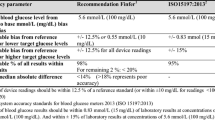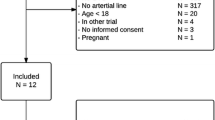Abstract
Objective
To evaluate the impact of circulatory shock requiring norepinephrine therapy on the accuracy and reliability of a subcutaneous continuous glucose monitoring system (CGMS) in critically ill patients.
Design and setting
A prospective, validation study of a medical intensive care unit at a university hospital was carried out.
Methods
Continuous glucose monitoring was performed subcutaneously in 50 consecutive patients on intensive insulin therapy (IIT), who were assessed according to the a priori strata of circulatory shock requiring norepinephrine therapy or not.
Results
A total of 736 pairs of sensor glucose (SG)/blood glucose (BG) values were analysed (502 without and 234 with norepinephrine therapy). For all values, repeated measures Bland–Altman analysis showed a mean difference of 0.08 mmol/l (limits of agreement: −1.26 and 1.43 mmol/l). Circulatory shock requiring norepinephrine therapy did not influence the relation of arterial BG with SG in a multivariable random effects linear regression analysis. The covariates norepinephrine dose, body mass index (BMI), glucose level and severity of illness also had no influence. Insulin titration grid analysis showed that 98.6% of the data points were in the acceptable treatment zone. No data were in the life-threatening zone.
Conclusions
Circulatory shock requiring norepinephrine therapy, as well as other covariates, had no influence on the accuracy and reliability of the CGMS in critically ill patients.


Similar content being viewed by others
References
Van den Berghe G, Wouters P, Weekers F, Verwaest C, Bruyninckx F, Schetz M, Vlasselaers D, Ferdinande P, Lauwers P, Bouillon R (2001) Intensive insulin therapy in the critically ill patients. N Engl J Med 345:1359–1367
Van den Berghe G, Wilmer A, Hermans G, Meersseman W, Wouters PJ, Milants I, Van Wijngaerden E, Bobbaers H, Bouillon R (2006) Intensive insulin therapy in the medical ICU. N Engl J Med 354:449–461
Honiden S, Schultz A, Im SA, Nierman DM, Gong MN (2008) Early versus late intravenous insulin administration in critically ill patients. Intensive Care Med 34(5):881–887
Lacherade JC, Jabre P, Bastuji-Garin S, Grimaldi D, Fangio P, Théron V, Outin H, De Jonghe B (2007) Failure to achieve glycemic control despite intensive insulin therapy in a medical ICU: incidence and influence on ICU mortality. Intensive Care Med 33:814–821
Vanhorebeek I, Langouche L, Van den Berghe G (2007) Tight blood glucose control with insulin in the ICU: facts and controversies. Chest 132:268–278
Brunkhorst FM, Engel C, Bloos F, Meier-Hellmann A, Ragaller M, Weiler N, Moerer O, Gruendling M, Oppert M, Grond S, Olthoff D, Jaschinski U, John S, Rossaint R, Welte T, Schaefer M, Kern P, Kuhnt E, Kiehntopf M, Hartog C, Natanson C, Loeffler M, Reinhart K; German Competence Network Sepsis (SepNet) (2008) Intensive insulin therapy and pentastarch resuscitation in severe sepsis. N Engl J Med 358:125–139
Devos P, Preiser J, Melot C (2007) Impact of tight glucose control by intensive insulin therapy on ICU mortality and the rate of hypoglycaemia: final results of the Glucontrol study. Intensive Care Med 33(Suppl 2):189
Wiener RS, Wiener DC, Larson RJ (2008) Benefits and risks of tight glucose control in critically ill adults: a meta-analysis. JAMA 300(8):933–944
De La Rosa Gdel C, Donado JH, Restrepo AH, Quintero AM, González LG, Saldarriaga NE, Bedoya M, Toro JM, Velásquez JB, Valencia JC, Arango CM, Aleman PH, Vasquez EM, Chavarriaga JC, Yepes A, Pulido W, Cadavid CA; Grupo de Investigacion en Cuidado intensivo: GICI-HPTU (2008) Strict glycaemic control in patients hospitalised in a mixed medical and surgical intensive care unit: a randomised clinical trial. Crit Care 12(5):R120
Aragon D (2006) Evaluation of nursing work effort and perceptions about blood glucose testing in tight glycemic control. Am J Crit Care 15:370–377
Vriesendorp TM, van Santen S, DeVries JH, de Jonge E, Rosendaal FR, Schultz MJ, Hoekstra JB (2006) Predisposing factors for hypoglycemia in the intensive care unit. Crit Care Med 34:96–101
Krinsley JS, Grover A (2007) Severe hypoglycemia in critically ill patients: risk factors and outcomes. Crit Care Med 35:2262–2267
Djakouré-Platonoff C, Radermercker R, Reach G, Slama G, Selam JI (2003) Accuracy of the continuous glucose monitoring system in inpatient and outpatient conditions. Diabetes Metab 29:159–162
Cheyne EH, Cavan DA, Kerr D (2002) Performance of a continuous glucose monitoring system during controlled hypoglycaemia in healthy volunteers. Diabetes Technol Ther 4:607–613
Rebrin K, Steil GM, van Antwerp WP, Mastrototaro JJ (1999) Subcutaneous glucose predicts plasma glucose independent of insulin: implications for continuous monitoring. Am J Physiol 277:E561–E571
Monsod TP, Flanagan DE, Rife F, Saenz R, Caprio S, Sherwin RS, Tamborlane WV (2002) Do sensor glucose levels accurately predict plasma glucose concentrations during hypoglycemia and hyperinsulinemia? Diabetes Care 25:889–893
Steil GM, Rebrin K, Mastrototaro J, Bernaba B, Saad MF (2003) Determination of plasma glucose during rapid glucose excursions with a subcutaneous glucose sensor. Diabetes Technol Ther 5:27–31
Chee F, Fernando T, van Heerden PV (2003) Closed-loop glucose control in critically ill patients using continuous glucose monitoring system (CGMS) in real time. IEEE Trans Inf Technol Biomed 7:43–53
Goldberg PA, Siegel MD, Russell RR, Sherwin RS, Halickman JI, Cooper DA, Dziura JD, Inzucchi SE (2004) Experience with the continuous glucose monitoring system in a medical intensive care unit. Diabetes Technol Ther 6:339–347
Ellmerer M, Haluzik M, Blaha J, Kremen J, Svacina S, Toller W, Mader J, Schaupp L, Plank J, Pieber T (2006) Clinical evaluation of alternative-site glucose measurements in patients after major cardiac surgery. Diabetes Care 29:1275–1281
De Block C, Manuel-Y-Keenoy B, Van Gaal L, Rogiers P (2006) Intensive insulin therapy in the intensive care unit: assessment by continuous glucose monitoring. Diabetes Care 29:1750–1756
Corstjens AM, Ligtenberg JJ, van der Horst IC, Spanjersberg R, Lind JS, Tulleken JE, Meertens JH, Zijlstra JG (2006) Accuracy and feasibility of point-of-care and continuous blood glucose analysis in critically ill ICU patients. Crit Care 10:R135
Vriesendorp TM, DeVries JH, Holleman F, Dzoljic M, Hoekstra JB (2005) The use of two continuous glucose sensors during and after surgery. Diabetes Technol Ther 7:315–322
De Backer D, Creteur J, Preiser JC, Dubois MJ, Vincent JL (2002) Microvascular blood flow is altered in patients with sepsis. Am J Respir Crit Care Med 166:98–104
Gillies R, Freeman JE, Cancio LC, Brand D, Hopmeier M, Mansfield JR (2003) Systemic effects of shock and resuscitation monitored by visible hyperspectral imaging. Diabetes Technol Ther 5:847–855
Cassuto J, Tarnow P, Yregård L, Lindblom L, Räntfors J (2005) Regulation of postburn ischemia by alpha- and beta-adrenoceptor subtypes. Burns 31:131–137
Knabl JS, Bauer W, Andel H, Schwendenwein I, Dado PF, Mittlböck M, Römer W, Choi MS, Horvat R, Meissl G, Frey M (1999) Progression of burn wound depth by systemical application of a vasoconstrictor: an experimental study with a new rabbit model. Burns 25:715–721
Bellomo R (2003) Noradrenaline: friend or foe? Heart Lung Circ 12(Suppl 2):S42–S48
Holzinger U, Warszawska J, Kitzberger R, Fuhrmann V, Schenk P, Herkner H, Madl C (2008) Accuracy and reliability of continuous glucose monitoring in critically ill patients. Crit Care Med 35(12 Suppl):A137
Holzinger U, Feldbacher M, Bachlechner A, Kitzberger R, Fuhrmann V, Madl C (2008) Improvement of glucose control in the intensive care unit: an interdisciplinary collaboration study. Am J Crit Care 17:150–156
Le Gall JR, Lemeshow S, Saulnier F (1993) A new Simplified Acute Physiology Score (SAPS II) based on a European/North American multicenter study. JAMA 270:2957–2963
Vincent JL, Moreno R, Takala J, Willatts S, De Mendonça A, Bruining H, Reinhart CK, Suter PM, Thijs LG (1996) The SOFA (Sepsis-Related Organ Failure Assessment) score to describe organ dysfunction/failure. On behalf of the Working Group on Sepsis-Related Problems of the European Society of Intensive Care Medicine. Intensive Care Med 22:707–710
Mastrototaro JJ (2000) The MiniMed continuous glucose monitoring system. Diabetes Technol Ther 2:S13–S18
Bland JM, Altman DG (1999) Measuring agreement in method comparison studies. Stat Methods Med Res 8:135–160
International Organization for Standardization (ISO) (2003) In vitro diagnostic test systems—requirements for blood-glucose monitoring systems for self-testing in managing diabetes mellitus. ISO 15197, International Organization for Standardization, Geneva, Switzerland
Krinsley JS (2003) Association between hyperglycemia and increased hospital mortality in a heterogeneous population of critically ill patients. Mayo Clin Proc 78:1471–1478
Krinsley JS (2004) Effect of an intensive glucose management protocol on the mortality of critically ill adult patients. Mayo Clin Proc 79:992–1000
Hoedemaekers CW, Klein Gunnewiek JM, Prinsen MA, Willems JL, Van der Hoeven JG (2008) Accuracy of bedside glucose measurement from three glucometers in critically ill patients. Crit Care Med 36(11):3062–3066
Critchell CD, Savarese V, Callahan A, Aboud C, Jabbour S, Marik P (2007) Accuracy of bedside capillary blood glucose measurements in critically ill patients. Intensive Care Med 33:2079–2084
Acknowledgements
The CGMS® System Gold™ apparatus and sensors were provided at no charge by Medtronic, Austria. No financial support was received for this work.
Author information
Authors and Affiliations
Corresponding author
Additional information
Rights and permissions
About this article
Cite this article
Holzinger, U., Warszawska, J., Kitzberger, R. et al. Impact of shock requiring norepinephrine on the accuracy and reliability of subcutaneous continuous glucose monitoring. Intensive Care Med 35, 1383–1389 (2009). https://doi.org/10.1007/s00134-009-1471-y
Received:
Accepted:
Published:
Issue Date:
DOI: https://doi.org/10.1007/s00134-009-1471-y




